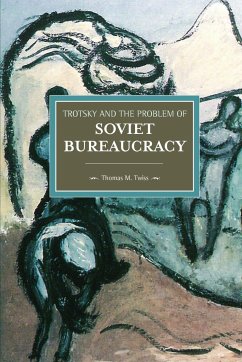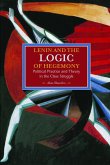Thomas Twiss
Trotsky and the Problem of Soviet Bureaucracy
Thomas Twiss
Trotsky and the Problem of Soviet Bureaucracy
- Broschiertes Buch
- Merkliste
- Auf die Merkliste
- Bewerten Bewerten
- Teilen
- Produkt teilen
- Produkterinnerung
- Produkterinnerung
Insightful and groundbreaking, Twiss's account of Trotsky's theory of post-revolutionary bureaucracy will soon become the definitive work on the subject.
Andere Kunden interessierten sich auch für
![Lenin and the Logic of Hegemony Lenin and the Logic of Hegemony]() Alan ShandroLenin and the Logic of Hegemony36,99 €
Alan ShandroLenin and the Logic of Hegemony36,99 €![Russia in the Context of Global Transformations Russia in the Context of Global Transformations]() Aleksandr BuzgalinRussia in the Context of Global Transformations31,99 €
Aleksandr BuzgalinRussia in the Context of Global Transformations31,99 €![The Dimensions of Hegemony The Dimensions of Hegemony]() Craig BrandistThe Dimensions of Hegemony31,99 €
Craig BrandistThe Dimensions of Hegemony31,99 €![The Thatcherite Offensive The Thatcherite Offensive]() Alexander GallasThe Thatcherite Offensive26,99 €
Alexander GallasThe Thatcherite Offensive26,99 €![War on War War on War]() R Craig NationWar on War19,99 €
R Craig NationWar on War19,99 €![Austro-Marxism: The Ideology of Unity. Volume II Austro-Marxism: The Ideology of Unity. Volume II]() Austro-Marxism: The Ideology of Unity. Volume II66,99 €
Austro-Marxism: The Ideology of Unity. Volume II66,99 €![State and Society in Eighteenth-Century France State and Society in Eighteenth-Century France]() Stephen MillerState and Society in Eighteenth-Century France26,99 €
Stephen MillerState and Society in Eighteenth-Century France26,99 €-
-
-
Insightful and groundbreaking, Twiss's account of Trotsky's theory of post-revolutionary bureaucracy will soon become the definitive work on the subject.
Produktdetails
- Produktdetails
- Verlag: Haymarket Books
- Seitenzahl: 502
- Erscheinungstermin: 19. Mai 2015
- Englisch
- Abmessung: 228mm x 149mm x 32mm
- Gewicht: 693g
- ISBN-13: 9781608464784
- ISBN-10: 1608464784
- Artikelnr.: 41626646
- Herstellerkennzeichnung
- Libri GmbH
- Europaallee 1
- 36244 Bad Hersfeld
- gpsr@libri.de
- Verlag: Haymarket Books
- Seitenzahl: 502
- Erscheinungstermin: 19. Mai 2015
- Englisch
- Abmessung: 228mm x 149mm x 32mm
- Gewicht: 693g
- ISBN-13: 9781608464784
- ISBN-10: 1608464784
- Artikelnr.: 41626646
- Herstellerkennzeichnung
- Libri GmbH
- Europaallee 1
- 36244 Bad Hersfeld
- gpsr@libri.de
Thomas Twiss Ph.D. (2009), Political Science, University of Pittsburgh, is a Liaison Librarian at that university. He has published articles on Leon Trotsky and translations of a number of Trotsky's letters
Preface
Introduction
1 Bureaucracy before October
1.1 Evolving meanings of bureaucracy
1.2 Bureaucracy in Russia
1.3 Marx and Engels on bureaucracy
1.4 After Marx and Engels
1.5 Conclusion
2 Revolution and the Problems of Bureaucracy
2.1 The dream deferred
2.2 The oppositions and political alienation 86
2.3 Lenin on political alienation and inefficiency
2.4 Trotsky and bureaucratic inefficiency
2.5 Conclusion
3 From Inefficiency to Political Alienation
3.1 Conflicts within the party leadership
3.2 Inefficiency and political alienation
3.3 The New Course controversy
3.4 Trotsky and the New Course
3.5 Political defeat and theoretical retreat
3.6 Conclusion
4 A Coherent Theory of Bureaucracy
4.1 The formation of the United Opposition
4.2 The struggle of the United Opposition
4.3 Trotsky and the Opposition on bureaucratism
4.4 On the eve of Thermidor
4.5 Conclusion
5 Left Turn and Theoretical Crisis
5.1 The beginning of the turn
5.2 Explaining the turn
5.3 The Stalinist offensive
5.4 Explaining the offensive
5.5 Defeating the right and continuing the turn
5.6 Explaining the new turn
5.7 Revising the theory
5.8 Conclusion
6 The Turn and the Theoretical Crisis Deepen
6.1 Economic upheaval
6.2 Trotsky's response to the turn
6.3 The left course in the Comintern
6.4 Trotsky and the Comintern's new strategy
6.5 Developments in the party regime
6.6 Trotsky and the regime
6.7 Modifying the theory
6.8 Conclusion
7 Theoretical Revolution
7.1 Breaking with the past
7.2 Revising the theory
7.3 New policy shifts
7.4 The Kirov assassination
7.5 Reinterpreting Bonapartism and Thermidor
7.6 Deeper shifts, repression, and a constitution
7.7 Conclusion
8 The Final Theory
8.1 The Revolution Betrayed
8.2 Applying the theory
8.3 Conclusion
9 Reconsidering Trotsky's Theory
9.1 The development of Trotsky's views
9.2 Evaluating the theory
Bibliography
Ind
Introduction
1 Bureaucracy before October
1.1 Evolving meanings of bureaucracy
1.2 Bureaucracy in Russia
1.3 Marx and Engels on bureaucracy
1.4 After Marx and Engels
1.5 Conclusion
2 Revolution and the Problems of Bureaucracy
2.1 The dream deferred
2.2 The oppositions and political alienation 86
2.3 Lenin on political alienation and inefficiency
2.4 Trotsky and bureaucratic inefficiency
2.5 Conclusion
3 From Inefficiency to Political Alienation
3.1 Conflicts within the party leadership
3.2 Inefficiency and political alienation
3.3 The New Course controversy
3.4 Trotsky and the New Course
3.5 Political defeat and theoretical retreat
3.6 Conclusion
4 A Coherent Theory of Bureaucracy
4.1 The formation of the United Opposition
4.2 The struggle of the United Opposition
4.3 Trotsky and the Opposition on bureaucratism
4.4 On the eve of Thermidor
4.5 Conclusion
5 Left Turn and Theoretical Crisis
5.1 The beginning of the turn
5.2 Explaining the turn
5.3 The Stalinist offensive
5.4 Explaining the offensive
5.5 Defeating the right and continuing the turn
5.6 Explaining the new turn
5.7 Revising the theory
5.8 Conclusion
6 The Turn and the Theoretical Crisis Deepen
6.1 Economic upheaval
6.2 Trotsky's response to the turn
6.3 The left course in the Comintern
6.4 Trotsky and the Comintern's new strategy
6.5 Developments in the party regime
6.6 Trotsky and the regime
6.7 Modifying the theory
6.8 Conclusion
7 Theoretical Revolution
7.1 Breaking with the past
7.2 Revising the theory
7.3 New policy shifts
7.4 The Kirov assassination
7.5 Reinterpreting Bonapartism and Thermidor
7.6 Deeper shifts, repression, and a constitution
7.7 Conclusion
8 The Final Theory
8.1 The Revolution Betrayed
8.2 Applying the theory
8.3 Conclusion
9 Reconsidering Trotsky's Theory
9.1 The development of Trotsky's views
9.2 Evaluating the theory
Bibliography
Ind
Preface
Introduction
1 Bureaucracy before October
1.1 Evolving meanings of bureaucracy
1.2 Bureaucracy in Russia
1.3 Marx and Engels on bureaucracy
1.4 After Marx and Engels
1.5 Conclusion
2 Revolution and the Problems of Bureaucracy
2.1 The dream deferred
2.2 The oppositions and political alienation 86
2.3 Lenin on political alienation and inefficiency
2.4 Trotsky and bureaucratic inefficiency
2.5 Conclusion
3 From Inefficiency to Political Alienation
3.1 Conflicts within the party leadership
3.2 Inefficiency and political alienation
3.3 The New Course controversy
3.4 Trotsky and the New Course
3.5 Political defeat and theoretical retreat
3.6 Conclusion
4 A Coherent Theory of Bureaucracy
4.1 The formation of the United Opposition
4.2 The struggle of the United Opposition
4.3 Trotsky and the Opposition on bureaucratism
4.4 On the eve of Thermidor
4.5 Conclusion
5 Left Turn and Theoretical Crisis
5.1 The beginning of the turn
5.2 Explaining the turn
5.3 The Stalinist offensive
5.4 Explaining the offensive
5.5 Defeating the right and continuing the turn
5.6 Explaining the new turn
5.7 Revising the theory
5.8 Conclusion
6 The Turn and the Theoretical Crisis Deepen
6.1 Economic upheaval
6.2 Trotsky's response to the turn
6.3 The left course in the Comintern
6.4 Trotsky and the Comintern's new strategy
6.5 Developments in the party regime
6.6 Trotsky and the regime
6.7 Modifying the theory
6.8 Conclusion
7 Theoretical Revolution
7.1 Breaking with the past
7.2 Revising the theory
7.3 New policy shifts
7.4 The Kirov assassination
7.5 Reinterpreting Bonapartism and Thermidor
7.6 Deeper shifts, repression, and a constitution
7.7 Conclusion
8 The Final Theory
8.1 The Revolution Betrayed
8.2 Applying the theory
8.3 Conclusion
9 Reconsidering Trotsky's Theory
9.1 The development of Trotsky's views
9.2 Evaluating the theory
Bibliography
Ind
Introduction
1 Bureaucracy before October
1.1 Evolving meanings of bureaucracy
1.2 Bureaucracy in Russia
1.3 Marx and Engels on bureaucracy
1.4 After Marx and Engels
1.5 Conclusion
2 Revolution and the Problems of Bureaucracy
2.1 The dream deferred
2.2 The oppositions and political alienation 86
2.3 Lenin on political alienation and inefficiency
2.4 Trotsky and bureaucratic inefficiency
2.5 Conclusion
3 From Inefficiency to Political Alienation
3.1 Conflicts within the party leadership
3.2 Inefficiency and political alienation
3.3 The New Course controversy
3.4 Trotsky and the New Course
3.5 Political defeat and theoretical retreat
3.6 Conclusion
4 A Coherent Theory of Bureaucracy
4.1 The formation of the United Opposition
4.2 The struggle of the United Opposition
4.3 Trotsky and the Opposition on bureaucratism
4.4 On the eve of Thermidor
4.5 Conclusion
5 Left Turn and Theoretical Crisis
5.1 The beginning of the turn
5.2 Explaining the turn
5.3 The Stalinist offensive
5.4 Explaining the offensive
5.5 Defeating the right and continuing the turn
5.6 Explaining the new turn
5.7 Revising the theory
5.8 Conclusion
6 The Turn and the Theoretical Crisis Deepen
6.1 Economic upheaval
6.2 Trotsky's response to the turn
6.3 The left course in the Comintern
6.4 Trotsky and the Comintern's new strategy
6.5 Developments in the party regime
6.6 Trotsky and the regime
6.7 Modifying the theory
6.8 Conclusion
7 Theoretical Revolution
7.1 Breaking with the past
7.2 Revising the theory
7.3 New policy shifts
7.4 The Kirov assassination
7.5 Reinterpreting Bonapartism and Thermidor
7.6 Deeper shifts, repression, and a constitution
7.7 Conclusion
8 The Final Theory
8.1 The Revolution Betrayed
8.2 Applying the theory
8.3 Conclusion
9 Reconsidering Trotsky's Theory
9.1 The development of Trotsky's views
9.2 Evaluating the theory
Bibliography
Ind








